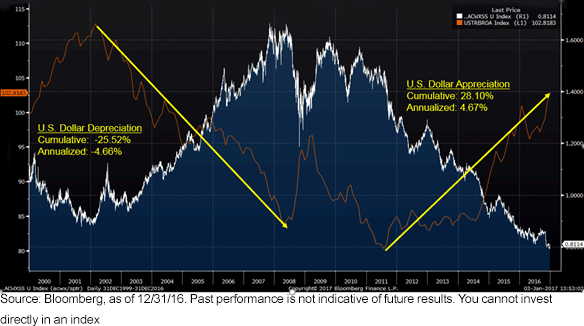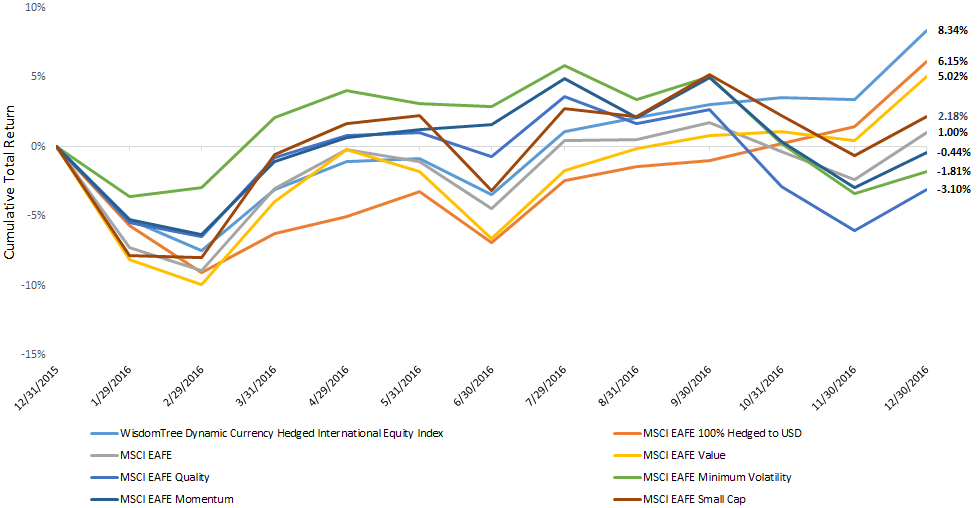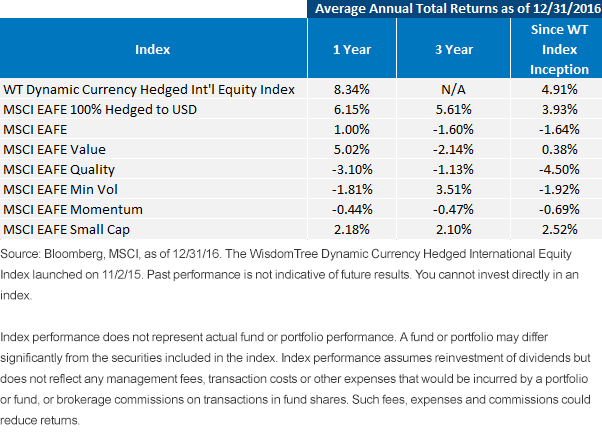Is the Dollar the Most Important Factor for International Investing?


2016 also reminded us that the U.S. dollar is often an important “factor” when investing outside the United States. Consider the MSCI ACWI ex-U.S. Index, which measures the returns of developed world and emerging markets stocks outside the U.S. In 2016, the MSCI ACWI ex-U.S. Index underperformed the S&P 500 Index for the fourth year in a row and for the fifth time in the last six years. The chart below plots the ratio of total returns (in white) generated by the MSCI ACWI ex-U.S. Index to those of the S&P 500 Index, going back to 2000. Note how that ratio rose from 2002 through early 2008 to more than 1.6, during a period when the U.S. dollar declined by about 25% against a basket of foreign currencies (in orange).1 Once that process reversed itself and the dollar began to appreciate again, beginning in the summer of 2011, the ratio of the MSCI ACWI ex-U.S. Index relative to the S&P 500 declined precipitously. Over that period, the dollar appreciated 28%, or roughly 4.7% per year. Many of the gains generated by foreign equity markets over those last five and a half years were washed away by losses posted by foreign currencies. In a low-yielding, low-return world, losing 4.5% per year due to foreign currency movements is not a formula for success.

Once an investor realizes that success in overseas investing is typically shaped by multi-year moves in the dollar, the question then becomes this: What is the best way to capitalize on this phenomenon while managing the risk that comes from foreign currency exposure? WisdomTree believes the answer is to dynamically hedge exposure to foreign currencies. Or stated another way, seek to capture the lion’s share of the foreign currency move when it helps you, and seek to avoid foreign currency exposure when it hurts you.
WisdomTree created an Index that makes this decision for you, at the end of each month, based on how foreign currencies are behaving relative to the U.S. dollar. The WisdomTree Dynamic Currency Hedged International Equity Index incorporates three signals—momentum, interest rate differentials and relative value based on purchasing power parity (PPP)—to determine how much foreign currency exposure to assume. It began 2017 with roughly 70% of foreign currencies hedged.
The chart below illustrates how well the WisdomTree Index did relative to the unhedged MSCI EAFE Index and to a 100% currency-hedged version of the MSCI EAFE.
The WisdomTree Index returned 8.3% in 2016, outperforming the MSCI EAFE Index by more than 7 percentage points and beating the 100% hedged version of the MSCI EAFE by 219 basis points (bps). As the chart and table below show, the impact these depreciating foreign currencies had on MSCI EAFE’s returns for U.S.-based investors—515 bps—had a bigger impact on returns in 2016 than did tilting toward MSCI EAFE Value, MSCI EAFE Quality, MSCI EAFE Minimal Volatility or even MSCI EAFE Small Cap.


For definitions of indexes in the chart, visit our glossary.
Although returns over many decades are not expected to be impacted by currency exposure in the developed world, in any given year, foreign currency exposure can impact returns as much or more than any of the so-called smart beta factors. This was true in 2016, and it has been true over the past three years. The strength of the U.S. dollar has had a greater impact on international equity returns than any of the commonly used smart beta factors, if MSCI EAFE is your proxy.
Most international equity managers measure themselves against the unhedged MSCI EAFE Index. And with last year’s paltry 1% return, many, like their benchmark, have generated negative returns over the past few years, disappointing U.S. investors. Much of the disappointment stems from international equity managers—and unhedged index funds—not having a viable strategy to manage foreign currency risk.
2017 could well be another year in which the U.S. dollar appreciates in value against other developed world currencies. That could once again pose a challenge for investors who own funds that buy stocks outside the United States. For investors looking to outsource the decision regarding when to hedge foreign currency exposure, WisdomTree has a one-stop solution. Launched in January 2016, the WisdomTree Dynamic Currency Hedged International Equity Fund (DDWM) provides broad exposure to the developed world equity markets while dynamically mitigating the impact of foreign currency exposure, using a rule-based algorithm that resets at the end of each month. Learn more about the WisdomTree Dynamic Currency Hedged International Equity Fund (DDWM).
1U.S. dollar uses the Real Trade Weighted U.S. Dollar Index from the St. Louis Fed.
Important Risks Related to this Article
There are risks associated with investing, including possible loss of principal. Foreign investing involves special risks, such as risk of loss from currency fluctuation or political or economic uncertainty. The Fund invests in derivatives in seeking to obtain a dynamic currency hedge exposure. Derivative investments can be volatile, and these investments may be less liquid than other securities, and more sensitive to the effects of varied economic conditions. Derivatives used by the Fund may not perform as intended. A Fund that has exposure to one or more sectors may be more vulnerable to any single economic or regulatory development. This may result in greater share price volatility. The composition of the Index underlying the Fund is heavily dependent on quantitative models and data from one or more third parties, and the Index may not perform as intended. The Fund invests in the securities included in, or representative of, its Index regardless of their investment merit, and the Fund does not attempt to outperform its Index or take defensive positions in declining markets. Please read the Fund’s prospectus for specific details regarding the Fund’s risk profile.

